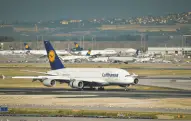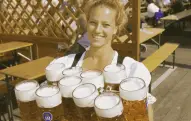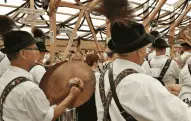MIGRANTAS, pictograms as a transcultural language
Mobility, migration and transculturality are not the exception in our world, but are instead becoming the rule. Nevertheless, migrant women and their experiences remain often invisible to the majority of our society.
MIGRANTAS, a collective NGO from Berlin, find a way to make visible, in the form of graphic icons, the inner feelings and situations that migrant women have to go through in their process of adopting new cultural manners.
Working with public urban spaces as its platform, Migrantas aims to make visible the thoughts and feelings of those who have left their own country and now live in a new one. They work with issues of migration, identity and intercultural dialogue. Their work incorporates tools from the visual arts, graphic design and social sciences. Members of the collective, mostly women who have themselves immigrated to Germany, develop the projects with other migrant women in a horizontal dialogue.
Migrantas meets with migrant women in their own collective spaces - organisations, community centres, cultural groups - and organizes workshops to reflect together on issues of migration. Women from very different national, cultural and social backgrounds, also with different residency statuses, exchange their experiences and express these in simple drawings.
After a careful analysis of all the drawings from different workshops, Migrantas culls key elements and common themes from the drawings and translates these central motifs visually and artistically into pictograms - a visual language and a language accessible to everyone.
Pictograms are the visual language. Their simple, universally understandable images stir emotions: people from different backgrounds recognize themselves in the representations, while others gain new insights or modify their own perspectives.
All Migrantas projects end with an exhibition. The participants now see their drawings presented in public and experience public recognition of their voices and social participation. Visitors to the exhibition receive an opportunity to become better acquainted with the experiences of migrant women. One of Migrantas major goals is to make the pictograms visible in public urban spaces. They appear as posters where there is normally advertising, as projected digital animations on public screens, as flyers or postcards or shopping bags. Migrant women's perspectives and lived realities are taken out of the individual private space and made visible in the public space, thus creating an encounter which triggers reactions and self-reflection in the passerby
The Migrantas collective receives no funding for its day-to-day work. Instead, the collective´s work is made possible through the commitment of its freelance members. The diverse projects undertaken by them, as well as those in which the collective participates, rely on direct funding or funding provided through partner organizations. Although the actual form of funding granted depends on the location and purpose of each project, it always remains strictly project-based. Migrantas has received funding from various institutions, and in the following, these organizations are clearly stated alongside the relevant projects.
Marula Di Como (graphic artist) has been using pictograms as a means of artistic expression since 2000, in Buenos Aires worked together with Florencia Young (graphic designer) on projects for the Goethe Institute such as, El futuro está en el papel pintado de la Bauhaus, in 1997, and Des- Límites, Valle del Riachuelo Matanza, directed by Prof. Matthias Sauerbruch in 1998. This last project was also on display in the, Di Tella Institute, and was chosen by the curator, Catherine David, for the exhibition City Editing, shown at the Proa Foundation in 1999 in Buenos Aires.
Marula and Florencia met again in Berlin in 2002 and started "Proyecto Ausländer". Between December 2003 and January 2004, an initial series of pictograms was shown on advertising hoardings in the center of Buenos Aires, Argentina, drawing attention, in the public arena, to an unpalatable fact of life in the city: looking at the problems of immigrants as if through a mirror and recognizing the anxiety of those who have been
forced to emigrate, as has happened to thousands of Argentinians since the 2001 crisis.
The communicative effect of the project was such that its creators decided to invite the sociologist Estela Schindel to broaden her personal perception to encompass the entire immigration phenomenon in Berlin, and extend the invitation to hundreds of women from different cultures and origins. By 2005, Migrantas had begun to take shape. In 2006 Irma Leinauer (urban planner) joined the collective, as did Alejandra López (journalist) in 2007. In 2011 Migrantas has been awarded with the Hauptstadtpreis für Toleranz und Integration ("Capital City Award for Tolerance and Integration") Initiative Hauptstadt Berlin e.V.
MIGRANTAS members
Marula Di Como
Born in Buenos Aires, Argentina in 1963 and has lived in Berlin since 2002. She is an artist, and has been exhibiting both on her own and with other artists since 1987 in differents formats and media, she developed her work in a context marked by the materiality of the tension between image and word, the relationship with nature and the feminine condition in the urban space. Her work can be found in museums, foundations, and private collections in Argentina and abroad.
Florencia Young
Born in Buenos Aires in 1965 and has lived in Berlin since 2002. She studied graphic design at the UBA (Buenos Aires), and has taught typography at universities from Argentina, Austria and Germany. She specializes in corporate identity design and multimedia stations, but is also involved in art installations and interdisciplinary projects.
Estela Schindel
Born in Buenos Aires in 1968 and has lived in Berlin since 1999. Dr. sociology.2005: Integration, 2006: Bilder bewegen, Interkulturelle Werkstatt, 2007: Bundesmigrantinnen Hamburg.
Irma Leinauer
Born in Peiting, Germany in 1958 and has lived in Berlin since 1985. Urban Planner.
2007: Bundesmigrantinnen Hamburg, 2008: Bundesmigrantinnen Köln, 2009: Postkarten-Sommer-Aktion, 2010: Sevilla Plural, Hier und dort Heimat, 2011: Europa-Kind + Europa-Schule, 2012: Unsere Neue Welt.
Alejandra López
Born in Resistencia, Argentina in 1973 and has lived in Berlin since 2001. Journalist.
2007: Bundesmigrantinnen Hamburg, 2008: Bundesmigrantinnen Köln, 2009: Postkarten-Sommer-Aktion, 2010: Sevilla Plural.










































